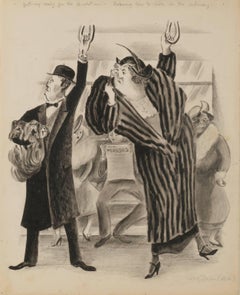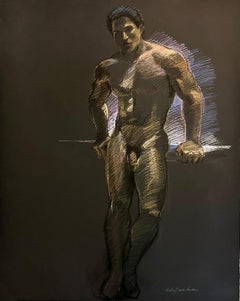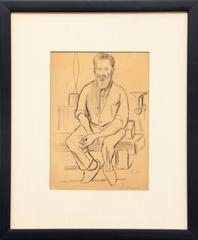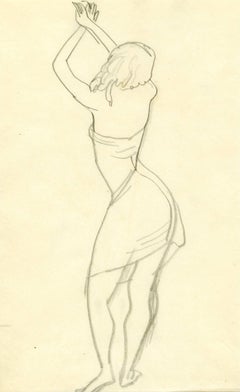Adolf Arthur Dehn Figurative Drawings and Watercolors
American, 1895-1968
Adolf Dehn, printmaker, watercolorist, and illustrator, was born in Waterville, Minnesota, in 1895. In 1914 he began studying at the Minneapolis School of Art, and in 1917, the year his first published drawing appeared in the progressive magazine, The Masses, he received a scholarship to study at the Art Students League in New York. There he worked with Kenneth Hayes Miller and was introduced to lithography by Boardman Robinson.
While in New York, Dehn threw himself into liberal politics. Declaring himself a conscientious objector in 1918, he was forced to spend four months in a Spartanburg, South Carolina, boot camp for refusing to serve in the armed forces and eight months as a volunteer instructor teaching painting and drawing at a hospital for war victims in Asheville, North Carolina.
Dehn spent the years 1920 to 1929 in art-related travel in Europe, primarily in Vienna and in Paris, where he made lithographs at the Atelier Desjobert. Throughout this time, Dehn exhibited his work at the Weyhe Gallery in New York and contributed drawings both to magazines abroad and to the radical journal The Masses.
Upon his return to New York in 1929, he became a leading figure in printmaking circles, exhibiting his prints to considerable critical acclaim. In 1937, Dehn had worked exclusively in black and white until 1937—halfway through his career—when he began to work in watercolor. During his summer visits to Minnesota, he created a large body of regional watercolors depicting the lakes and farms of his home state. Lithography and watercolor remained his two primary media, and his subjects ranged from social satire to naturalistic landscapes.
He authored the treatise, Water Color Painting, in 1945 and two other instructional books on lithography and watercolor in 1950 and 1955. From 1938 to 1939 he taught at Stephens College in Columbia, Missouri, and during the summers of 1940-1942 he taught at the Colorado Springs Fine Arts Center.
In 1939 and 1951 Dehn received Guggenheim Fellowships, and 1961 he was elected Full Academician to the National Academy of Design.
Dehn exhibited throughout his career, and his works are in the permanent collections of the Metropolitan Museum of Art, the Museum of Modern Art, the Art Institute of Chicago, the Museum of Fine Arts in Boston, and the British Museum, among others.
Adolf Dehn died in New York in 1968.to
2
Overall Width
to
Overall Height
to
2
1
1
2
1
1
1
1
1
1
1
1
1
1
1
12
896
324
192
181
1
2
Artist: Adolf Arthur Dehn
Getting Ready for the Revolution - Learning How to Ride in the Subway
By Adolf Arthur Dehn
Located in Fairlawn, OH
Getting Ready for the Revolution - Learning How to Ride in the Subway
Litho crayons on illustrator’s board, c. 1932
Signed: Adolf Dehn (VED) lower right corner (signed by Virginia Dehn, the artist’s widow)
Tilted along the upper edge of the recto in pencil by the artist
Verso inscriptions: “VF 3168.D” in a circle, also annotated in red pencil “32” in a circle and “699
Provenance:
Mary Ryan Gallery, exhibition entitled Adolf Dehn Lithographs, 1927-1940, Nov. 16 to Dec. 12, 1982. The original exhibition notice us affixed to the backing board of the frame
Note: A drawing intended or used in the publication Vanity Fair, for whom Dehn worked in the mid 1920’s to the 1930’s.
Adolf Dehn, American Watercolorist and Printmaker, 1895-1968
Adolf Dehn was an artist who achieved extraordinary artistic heights, but in a very particular artistic sphere—not so much in oil painting as in watercolor and lithography. Long recognized as a master by serious print collectors, he is gradually gaining recognition as a notable and influential figure in the overall history of American art.
In the 19th century, with the invention of the rotary press, which made possible enormous print runs, and the development of the popular, mass-market magazines, newspaper and magazine illustration developed into an artistic realm of its own, often surprisingly divorced from the world of museums and art exhibitions, and today remains surprisingly overlooked by most art historians. Dehn in many regards was an outgrowth of this world, although in an unusual way, since as a young man he produced most of his illustrative work not for popular magazines, such as The Saturday Evening Post, but rather for radical journals, such as The Masses or The Liberator, or artistic “little magazines” such as The Dial. This background established the foundation of his outlook, and led later to his unique and distinctive contribution to American graphic art.
If there’s a distinctive quality to his work, it was his skill in introducing unusual tonal and textural effects into his work, particularly in printmaking but also in watercolor. Jackson Pollock seems to have been one of many notable artists who were influenced by his techniques.
Early Years, 1895-1922
For an artist largely remembered for scenes of Vienna and Paris, Adolf Dehn’s background was a surprising one. Born in Waterville, Minnesota, on November 22, 1895, Dehn was the descendent of farmers who had emigrated from Germany and homesteaded in the region, initially in a one-room log cabin with a dirt floor. Adolf’s father, Arthur Clark Dehn, was a hunter and trapper who took pride that he had no boss but himself, and who had little use for art. Indeed, during Adolf’s boyhood the walls of his bedroom and the space under his bed were filled with the pelts of mink, muskrats and skunks that his father had killed, skinned and stretched on drying boards. It was Adolf’s mother, Emilie Haas Dehn, a faithful member of the German Lutheran Evangelical Church, who encouraged his interest in art, which became apparent early in childhood. Both parents were ardent socialists, and supporters of Eugene Debs...
Category
1930s American Modern Adolf Arthur Dehn Figurative Drawings and Watercolors
Materials
Oil Crayon
Adolf Dehn, Haitian Scene A, signed painting, Associated American Artists, 1950s
By Adolf Arthur Dehn
Located in New York, NY
Adolf Arthur Dehn
Haitian Scene A, ca. 1951
Watercolor gouache on board
Signed on the front
Frame included: held in vintage modern frame
Measurements:
Framed:
11 inches vertical by 13 inches horizontal by .75
Painting
4.5 inches by 6 inches
Watercolor gouache, hand signed; framed with AAA Gallery label verso
Signed on the front bearing the original label on the verso of Dehn's longtime gallery, the prestigious Associated American Artists Gallery, New York City.
Provenance
Associated American Artists
Frame included: held in vintage frame with original label as provenance
Dehn, an influential artist and teacher (and author of the definitive textbook of his era on watercolor painting) joined Associated American Artists gallery in 1941. Although this painting is undated, it is likely circa early 1950s, as in 1951 Dehn won a Guggenheim Fellowship, which enabled him to travel to Haiti -- the subject of this work. It was part of a series inspired by Dehn's visit to Haiti.
Dehn, an influential artist and teacher (and author of the definitive textbook of his era on watercolor painting) joined Associated American Artists gallery in 1941. Although this painting is undated, it is likely circa early 1950s, as in 1951 Dehn won a Guggenheim Fellowship, which enabled him to travel to Haiti.
ADLOF DEHN
Adolf Dehn, American Watercolorist and Printmaker, 1895-1968
Adolf Dehn was an artist who achieved extraordinary artistic heights, but in a very particular artistic sphere - not so much in oil painting as in watercolor and lithography. Long recognized as a master by serious print collectors, he is gradually gaining recognition as a notable and influential figure in the overall history of American art.
In the 19th century, with the invention of the rotary press, which made possible enormous print runs, and the development of the popular, mass-market magazines, newspaper and magazine illustration developed into an artistic realm of its own, often surprisingly divorced from the world of museums and art exhibitions, and today remains surprisingly overlooked by most art historians. Dehn in many regards was an outgrowth of this world, although in an unusual way, since as a young man he produced most of his illustrative work not for popular magazines, such as The Saturday Evening Post, but rather for radical journals, such as The Masses or The Liberator, or artistic "little magazines" such as The Dial. This background established the foundation of his outlook, and led later to his unique and distinctive contribution to American graphic art.
If there’s a distinctive quality to his work, it was his skill in introducing unusual tonal and textural effects into his work, particularly in printmaking but also in watercolor. Jackson Pollock seems to have been one of many notable artists who were influenced by his techniques.
Early Years, 1895 - 1922
For an artist largely remembered for scenes of Vienna and Paris, Adolf Dehn’s background was a surprising one. Born in Waterville, Minnesota, on November 22, 1895, Dehn was the descendent of farmers who had emigrated from Germany and homesteaded in the region, initially in a one-room log cabin with a dirt floor. Adolf’s father, Arthur Clark Dehn, was a hunter and trapper who took pride that he had no boss but himself, and who had little use for art. Indeed, during Adolf’s boyhood the walls of his bedroom and the space under his bed were filled with the pelts of mink, muskrats and skunks that his father had killed, skinned and stretched on drying boards. It was Adolf’s mother, Emilie Haas Dehn, a faithful member of the German Lutheran Evangelical Church, who encouraged his interest in art, which became apparent early in childhood. Both parents were ardent socialists, and supporters of Eugene Debs...
Category
1950s Modern Adolf Arthur Dehn Figurative Drawings and Watercolors
Materials
Watercolor, Gouache, Board
Related Items
Adonis, pastel drawing on oversize black paper, muscular male nude
By Audrey Anastasi
Located in Brooklyn, NY
These recently discovered 1983-84 oversize pastels on archival papers were created working quickly, in pastel. The series shows the last existing obs...
Category
2010s American Modern Adolf Arthur Dehn Figurative Drawings and Watercolors
Materials
Pastel, Mixed Media, Archival Paper
$1,800
H 40 in W 32 in D 0.1 in
1950's Modernist Painting - Portrait Of Figure On Gold
By Bernard Labbe
Located in Cirencester, Gloucestershire
Gold Man
by Bernard Labbe (French mid 20th century), stamped verso
original watercolour/gouache painting on paper
overall size: 111.75 x 8.5 inches
condition: very good and ready to...
Category
Mid-20th Century Modern Adolf Arthur Dehn Figurative Drawings and Watercolors
Materials
Watercolor, Gouache
$478 Sale Price
30% Off
H 11.75 in W 8.75 in
A 1950s Pastel & Charcoal on Paper Drawing of a Hockey Game by Francis Chapin
By Francis Chapin
Located in Chicago, IL
Perfect for you hockey enthusiast! A 1950s pastel & charcoal on paper drawing of a hockey game by artist Francis Chapin. Artwork size: 9" x 12". Matted size: 14" x 18". Provenance: Estate of the Artist.
Francis Chapin, affectionately called the “Dean of Chicago Painters” by his colleagues, was one of the city’s most popular and celebrated painters in his day. Born at the dawn of the 20th Century in Bristolville, Ohio, Chapin graduated from Washington & Jefferson College near Pittsburgh, Pennsylvania before enrolling at the Art Institute of Chicago in 1922. He would set down deep roots at the Art Institute of Chicago, exhibiting there over 31 times between 1926 and 1951. In 1927 Chapin won the prestigious Bryan Lathrop Fellowship from the Art Institute – a prize that funded the artist’s yearlong study trip to Europe. Upon his return to the United States, Chapin decided to remain in Chicago, noting the freedom Chicago artists have in developing independently of the pressure to conform to pre-existing molds (as was experienced by artists in New York, for example). Chapin became a popular instructor at the Art Institute, teaching there from 1929 to 1947 and at the Art Institute’s summer art school in Saugatuck, Michigan (now called Oxbow) between 1934 – 1938 (he was the director of the school from 1941-1945). Chapin’s contemporaries among Chicago’s artists included such luminaries as Ivan Le Lorraine Albright...
Category
1950s American Modern Adolf Arthur Dehn Figurative Drawings and Watercolors
Materials
Paper, Charcoal, Pastel
Supermodels in Vogue, Watercolor Fashion Painting
By Manuel Santelices
Located in Miami Beach, FL
The artist has covered New York collections for over 16 years and has interviewed, as a journalist, several fashion designers and personalities for different publications. He loves t...
Category
21st Century and Contemporary Contemporary Adolf Arthur Dehn Figurative Drawings and Watercolors
Materials
Paper, Ink, Watercolor, Gouache
$950
H 14 in W 11 in D 0.1 in
A Fine 1930s, Modern Academic Pastel Figure Study of a Seated Male Nude Model
By Harold Haydon
Located in Chicago, IL
A Fine 1930s, Modern Academic Pastel Figure Study of a Seated Male Nude Model by Notable Chicago Artist, Harold Haydon (Am. 1909-1994). An exceptionally well executed, early 1930s p...
Category
1930s American Modern Adolf Arthur Dehn Figurative Drawings and Watercolors
Materials
Pastel, Paper
$265
H 24 in W 18 in D 0.13 in
A Fine 1930s, Modern Academic Pastel Figure Study of a Standing Male Nude (Back)
By Harold Haydon
Located in Chicago, IL
A Fine 1930s, Modern Academic Pastel Figure Study of a Standing Male Nude Model (Back) by Notable Chicago Artist, Harold Haydon (Am. 1909-1994). An exceptionally well executed, earl...
Category
1930s American Modern Adolf Arthur Dehn Figurative Drawings and Watercolors
Materials
Paper, Pastel
$265
H 24 in W 18 in D 0.13 in
A Fine 1930's, Depiction of a Boxing Match
By Francis Chapin
Located in Chicago, IL
A Fine 1930's, Depiction of a Boxing Match by Francis Chapin. This dynamic drawing captures overlapping human forms rendered in expressive, gestural lines. There is a clear sense of ...
Category
1930s American Modern Adolf Arthur Dehn Figurative Drawings and Watercolors
Materials
Charcoal, Paper, Pastel
"Central Park" Leon Dolice, New York Central Park Scene, Mid-Century
By Leon Dolice
Located in New York, NY
Leon Dolice
Central Park
Signed lower left
Watercolor on paper
12 x 19 inches
The romantic backdrop of Vienna at the turn of the century had a life-long influence upon the young ma...
Category
1930s American Modern Adolf Arthur Dehn Figurative Drawings and Watercolors
Materials
Paper, Pastel
Pat Buckley leaving town. From The Art, culture & society Series
By Manuel Santelices
Located in Miami Beach, FL
Movies, TV and magazines are constant source of inspiration. Fame, as fleckring and shallow it can be sometimes, is very intriguing to him.
The worlds of fashion, society and pop cu...
Category
21st Century and Contemporary Contemporary Adolf Arthur Dehn Figurative Drawings and Watercolors
Materials
Paper, Ink, Watercolor, Gouache
$950
H 14 in W 11 in D 0.1 in
A Striking 1945 Mid-Century Modern Figure Study of a Standing Black Female Nude
By Harold Haydon
Located in Chicago, IL
A Striking, 1945 Mid-Century Modern Figure Study of a Standing Female Nude African-American Model by Notable Chicago Artist, Harold Haydon (Am. 1909-1994). A beautifully drawn and i...
Category
Mid-20th Century American Modern Adolf Arthur Dehn Figurative Drawings and Watercolors
Materials
Paper, Charcoal, Pastel
$165
H 14 in W 8 in D 0.13 in
Belle Epoque Romantic Pastel Portrait of a Spanish Beauty, Conchita de Cadiz
Located in Cotignac, FR
Romantic French pastel portrait of a Spanish beauty by Louis Fortuney. The work is signed bottom right, titled to the back board and presented in a fine...
Category
Early 20th Century Romantic Adolf Arthur Dehn Figurative Drawings and Watercolors
Materials
Pastel
$894
H 15.75 in W 13 in D 0.79 in
1930's French Portrait Sketch of a Lady, Listed French painter
By Leon Launay
Located in Cirencester, Gloucestershire
"Portrait of a Lady"
by Leon Launay (French 1890-1956)
charcoal portrait drawing on paper, unframed
stamped verso
painting: 18.5 x 12 inches
Condition report:
The painting is in go...
Category
Early 20th Century Impressionist Adolf Arthur Dehn Figurative Drawings and Watercolors
Materials
Charcoal
$379
H 18.5 in W 12.5 in
Previously Available Items
Brancusi
By Adolf Arthur Dehn
Located in Denver, CO
Portrait of sculptor, Constantin Brâncuși (1876-1957).
Graphite on paper. Housed in a custom frame with archival materials. Outer dimensions are 17.5 x 14.5 x 0.75 inches; image m...
Category
Mid-20th Century American Modern Adolf Arthur Dehn Figurative Drawings and Watercolors
Materials
Graphite
Untitled (Woman with Upraised Arms)
By Adolf Arthur Dehn
Located in Fairlawn, OH
Pencil on paper
Unsigned
Provenance:
Estate of the artist
From a sketchbook
Category
1920s Adolf Arthur Dehn Figurative Drawings and Watercolors
Materials
Graphite
Adolf Arthur Dehn figurative drawings and watercolors for sale on 1stDibs.
Find a wide variety of authentic Adolf Arthur Dehn figurative drawings and watercolors available for sale on 1stDibs. You can also browse by medium to find art by Adolf Arthur Dehn in ink, crayon, oil crayon and more. Not every interior allows for large Adolf Arthur Dehn figurative drawings and watercolors, so small editions measuring 9 inches across are available. Customers who are interested in this artist might also find the work of Thelma Terrell, Monte Crews, and Michael Loew. Adolf Arthur Dehn figurative drawings and watercolors prices can differ depending upon medium, time period and other attributes. On 1stDibs, the price for these items starts at $1,200 and tops out at $3,500, while the average work can sell for $2,500.





